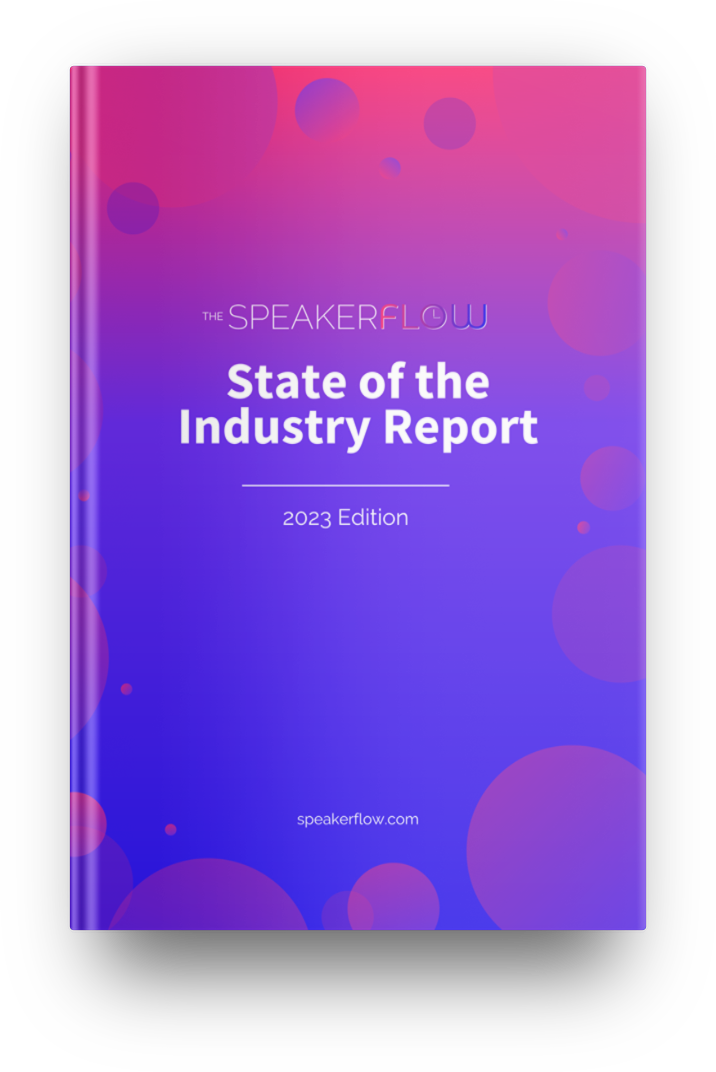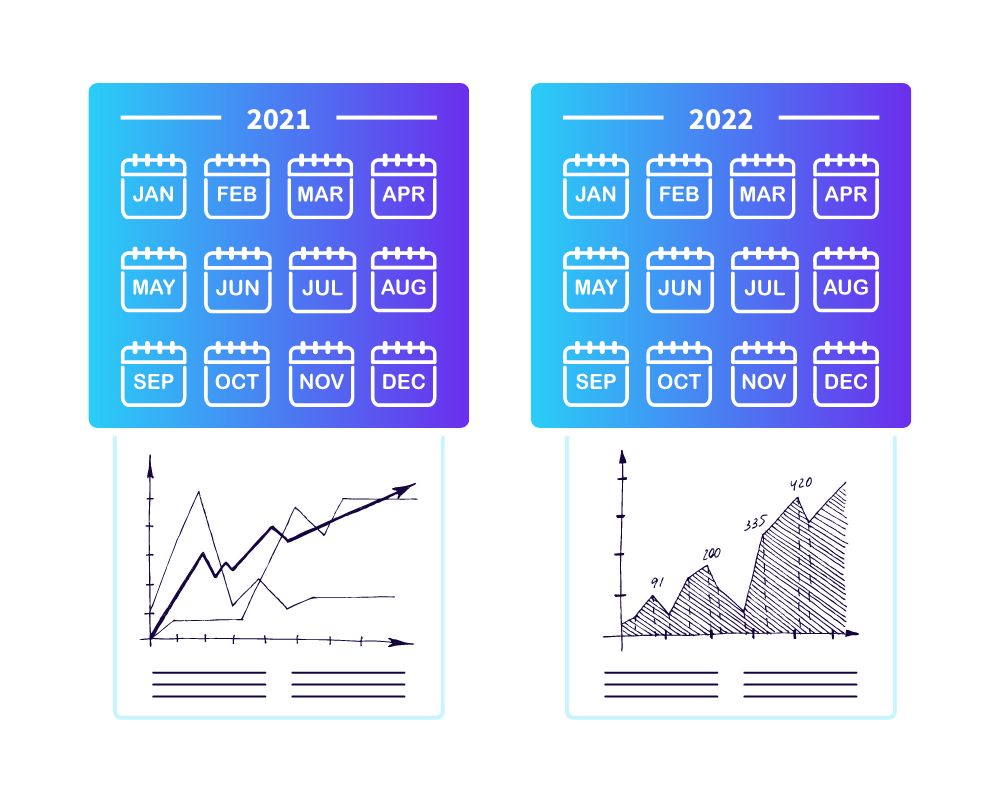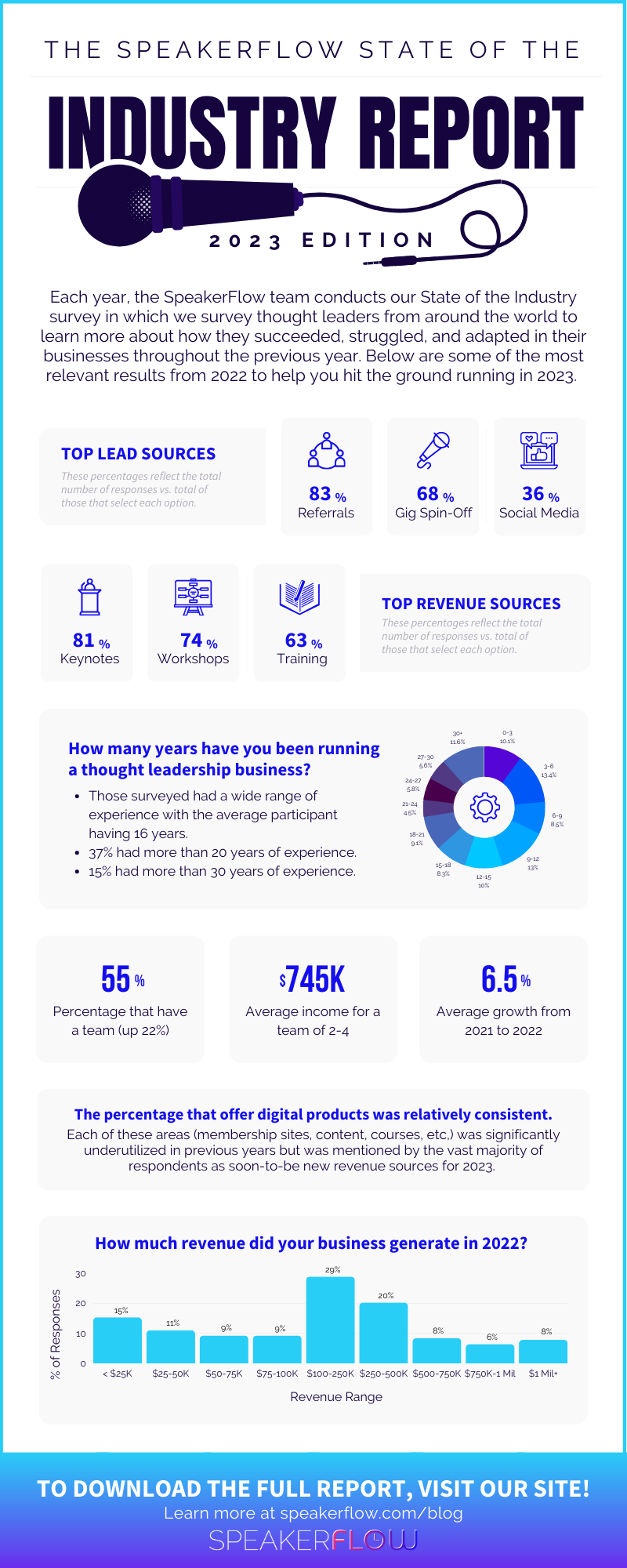It’s not exactly a secret among business owners that the more data you have, the more quickly you can grow. Whether it’s data about your sales, marketing, or operational performance, the only way to see where you stand – and judge whether or not you need to make changes – is to keep records. From there, all it takes is a quick comparison with others in your industry to see what you could be doing better.
That’s why, for the past few years, the SpeakerFlow team has run our annual State of the Industry Report. Tailored to the thought leadership industry, this report compiles responses from business owners around the world. We’ve surveyed professional speakers, coaches, consultants, authors – anyone who labels themselves a “thought leader.” This year, that’s allowed us to produce our most comprehensive report yet, one that’s representative of $114 million earned in 2022 and encompasses over 7,000 collective years of experience across 18 different countries.
As in previous years, our 2023 report includes a range of stats related to various aspects of running a thought leadership business such as sales offerings and fees and the technology used to make it all happen. It also highlights key insights so you can translate this information into action in the coming year.
With all of that said, let’s get into the details!
As always, if you’d like to learn more about our reporting process or, if you’re looking for systems to help you make the most of these findings, book a call! Wherever you are in your journey to building a thought leadership business, we’re here to help. 👍
Download the Latest Report 👇
We collected insights, trends, and research from thought leaders in every stage of the business.
Here’s what we learned from their experiences in 2022.

Thought Leadership Industry Overview
Before we get into the nitty-gritty details, let’s talk about the industry as a whole. In this year’s report, you may have noticed that the name changed from our previous “State of the Speaking Industry Report” to the “SpeakerFlow State of the Industry Report.” This was to account for the many people that, while running similar businesses, don’t solely focus on professional speaking.

Put simply, we didn’t want to focus strictly on speakers when we reached out, asking for survey participants. We wanted to include anyone that markets themselves as an expert and whose sales offerings leverage that expertise. This includes professional speakers but also the many titles mentioned above (coaches, consultants, authors, etc).
In combination with this new, broader participant base, we also designed our 2023 survey with elevated intention. For instance, in 2020 or 2021, when we might have asked, “Do you have a team?” we instead asked, “What do you delegate within your team?” and “How do thought leadership businesses with teams monetarily compare to those without?” We also invited those in our network to share their thoughts so we could address their most pressing questions directly. The following section summarizes these questions.
Questions You Had
The nine questions below were posed by members of the thought leadership industry including – but not limited to – SpeakerFlow clients, partners, and participants in the State of the Industry Survey used for this report.
In most cases, questions not only posed a “yes” or “no” prompt but also implied directional ones. For instance, “Do those that use a CRM make more money?” also indirectly asked whether or not you should be using a CRM in the future. Below each question, we’ve outlined each of these actions. That way, you can make the most of the corresponding answers.
Q: How old is the average thought leadership business?
A: The average thought leadership business is about 16 years old. However, the top earning 10% of these businesses are, generally, about seven years older than those in the lower-earning 90%.
Takeaway: While investing in business strategies is well worth the time and money, being patient and consistent also plays a role. If you’re at the beginning of this journey, keep at it. Sometimes, the best thing you can do to grow your business is avoid “squirrel chasing” new strategies or tools and simply be diligent.
Q: Do those that use a CRM make more money?
A: Yes, by a long shot! On average, thought leadership businesses that use a customer relationship management tool (CRM) to manage new and ongoing relationships bring in 2-7 times more revenue than those that don’t use a CRM. In fact, those that do not use a CRM make ~$130,000 annually while those that do make ~$360,000. Even more striking was the maximum revenue reported: $800,000 annually from those without a CRM and $5.6 million from those with one.
Takeaway: If you’re not already actively using a CRM, now is the time. We may sound like a bit of a broken record, given that we cover this in a large number of our blogs and previous SSI reports, but the numbers don’t lie. A CRM allows you to more effectively prioritize your sales efforts, so you can close more deals in less time. This is true regardless of the size of your thought leadership business or the industry(ies) on which you focus.
Q: Do those that have a team make more money?
A: Yes, they do. A “team” can refer to legal employees, independent contractors, or a mix of both. And, on average, thought leadership businesses that employ a team make 3-5 times more money than those without one. This was once again supported by a drastic gap in revenue with solopreneurs making ~$128,000 annually and teams making ~$456,000. The maximum annual revenue mirrored this trend as well: $1 million annually from those without a team and $5.6 million from those with one.
Takeaway: The phrase “delegate and elevate” is only gaining validity year after year. As is evident by the aforementioned stats, sharing your workload with others may not be inexpensive. That said, it pays off many times over, both monetarily and in terms of your personal happiness. After all, if you didn’t absolutely have to do everything yourself and you’d make more money by delegating, why not start now?
A few of the most popular outsourcing platforms are Fiverr and Upwork. I also highly recommend this comparison article, which breaks down the pros and cons of each network.
Q: Do those that touch base regularly (annually or quarterly) with past clients make more money?
A: Another “yes”. On average, thought leadership businesses that regularly check in with previous clients bring in more revenue (up to 2 times more, to be exact). This amounts to average annual revenue of $255,000 for those that don’t check in and $361,000 for those that do. As expected, the maximum annual revenue numbers once again reflected this: $2.5 million annually from the “no check-in” crowd and $5 million from the other.
Takeaway: Despite the temptation to chase new leads, your greatest source of revenue will always be those who’ve already hired you and, consequently, know how amazing you are. Even if they can’t purchase your products right now or hire you for their next event, set regular follow-up tasks for them. These can be an email, a quick phone call, or even a Zoom meeting. Whatever best suits their needs and your schedule, keep your relationships with these clients alive so, when they next have a chance to spend some money, they look to you and your offerings first.
Q: Which revenue streams are the most and least common for top earners?
A: Among the top 10% of thought leadership businesses, the most common revenue streams – from most to least – are content production, entertainment, sponsorships, physical products, and licensing. The other 90% of businesses bring in the bulk of their revenue from memberships and retreats, although entertainment, sponsorships, and physical products are also in their top five.
Takeaway: Though there’s undeniable value in each of these revenue streams, the highest-earning thought leadership businesses prioritize those that don’t require constant attention. For example, the bottom 90% of thought leadership businesses don’t offer licensing. But, in the top 10% of these businesses, 22% leverage it as a revenue stream.
Considering this, brainstorm which resources best suit your target audience and build them into your goals for the next year. Can you turn your keynote presentation into a training framework that you can then license to companies in your audience? What about workbooks or courses that complement your book(s)? Look for ways to create a product once that then suits a variety of clients without added time and energy.
Q: How are top-earning thought leaders’ sources of leads different from those of lower earners?
A: The highest-earning thought leaders rely on organic search 13% more than others in the industry. They also rely on social media 21% more. In other words, rather than sourcing the majority of their leads from outside sources, they invest in areas where their audience is already active.
Takeaway: Every business owner’s dream is for leads to “just come to them,” but that doesn’t happen without work. To consistently attract new leads in your own business, devote time (and money, if outsourcing) to inbound lead sources. Below are a few ways to get started.
- SEO optimize your website pages and your content (blog posts, podcast episodes, YouTube videos, etc). Find out which keywords and phrases people in your target audience are searching for. Then, use them strategically so that, when they search, your content shows up at the top of the list.
- Publish new content consistently. It takes, on average, six months to a year for webpages to “actualize” and show up in search engine results for their keyword. Publishing on a regular basis is equivalent to investing in your future leads from these searches.
- Post and engage consistently on social media. You don’t have to live online or even use every platform, but being active on social media demonstrates your authority, your willingness to share valuable information, and your commitment to your audience. All of those things drive people to your website where they become leads.
Q: What’s the difference of paid vs. free gigs between the top 10% and bottom 90% of thought leadership businesses?
A: In the lower 90% of thought leadership businesses, 42% booked more than 20 paid gigs in 2022 and 10% booked more than 50. In the upper 10% of thought leadership businesses, 63% booked more than 20 paid gigs, and a whopping 38% booked more than 50. The percentage of businesses that booked fewer than five free gigs in 2022 was roughly the same for each group (63% for the upper 90% and 62% for the upper 10%).
Takeaway: While speaking engagements aren’t the #1 source of revenue for top thought leaders, they’re certainly not an afterthought. Likewise, in your own business, don’t discount the value of your speaking programs, and test new prices so you can command the maximum fee possible per gig. Even if your primary goal isn’t to be a professional speaker, each gig is a chance to segue your presentation into a longer client relationship with add-on products and services. Don’t let those opportunities slip through the cracks.
Q: Do thought leaders that book more free speaking gigs also book more paid speaking gigs?
A: Yes. On average, those that book fewer free gigs book slightly more paid gigs and earn more revenue. To be exact, 47% of thought leaders that book less than 5 free gigs annually also book more than 20 paid gigs. 43% of those with more than 5 free gigs also book more than 20 paid gigs.
Takeaway: One of the most common arguments for free speaking gigs is, “Well, even if we can’t pay you, you’ll still get exposure from this event.” However, that’s not always true. Especially if you’re an established speaker, free events are occasionally appropriate (a charity event, for example) but your energy is better spent at events that can return your investment. If someone is lowballing you in a sales conversation, they may simply not be a fit for your speaking programs.
Q: How do I improve my chances of getting paid gigs?
There are endless ways to answer this question, and the value of each varies from business to business. That said, of those we surveyed, the following points were true among thought leaders that deliver 25+ gigs per year.
- They say keynoting is their most profitable revenue stream 17% more often than those that have less than 25 gigs per year.
- They book 12% more spin-off business. This includes the sale of other products or services after each speaking event is over.
- They get nearly double the business from speakers bureaus.
- They use a CRM 11% more often.
- They engage on social media 13% more often.
- They practice partnership marketing 11% more often.
- They invest in public relations (PR) outreach 11% more often.
Additional Takeaways:
- 45% of survey participants in 2022 indicated that they were solopreneurs (i.e. did not have a team). This is down drastically from 2021’s 67% and denotes a shift from the “doing it all” mindset to an increasing willingness to outsource projects/tasks.
- The percentage of thought leaders that are part of a professional speaking association has increased from 59% in 2021 to almost 80% in 2022. The most popular associations among those surveyed were the National Speakers Association (NSA) in the United States and the Global Speakers Federation (GSF).
- The age of the average thought leader remained consistent in recent years, between 50-60 years old. The most common response among survey respondents, when asked for their age, was 55-64 years old. Less than 1$ said they preferred to keep their age private.
Thought Leadership vs Other Small Businesses
After an industry overview, the next segment of the 2023 Report looked at a bird’s eye view of entrepreneurship. Put simply, we wanted to answer the question, “How do thought leadership businesses stack up compared to other small businesses?” And the short answer is… well, dramatically better.

For starters, thought leaders make more money than the average small business owner. As a solopreneur, the average thought leader brings in $128,000 annually compared to the average small business solopreneur’s $44,000. Likewise, the average thought leadership team of 2-4 brings in $745,000 per year, dwarfing similar small business teams’ revenue of $387,000 per year. This ability to bring in revenue was also reflected in the average age of thought leadership businesses compared to that of small businesses, 16 and 7 years respectively.
Combined, these stats suggest that thought leadership businesses generally have more staying power – that is, the ability to withstand industry upheaval – than small businesses. This could be due to a number of reasons such as the ease with which thought leaders operate virtually, which makes them less vulnerable to changes that impact in-person sales (disease, natural disasters, etc). Another possibility is the frequency with which thought leaders segue into their business gradually while maintaining their initial career, which often allows for slower, steadier growth.
None of this is to say that either side of the equation is easier, just that it’s clear why the thought leadership industry continues to grow worldwide. After all, who wouldn’t want to be paid for their expertise, all while getting to be their own boss, choose their own hours, and see considerably steeper benefits than other business owners? Win, win, win!
Sales Stats Overview
The third section of the 2023 State of the Industry Report was all about revenue. This included common sales practices, lead and revenue sources, and – for the first time in our history of reports – sales offering-specific stats. Think data about average speaking fees and coaching or consulting costs.
For the most part, each of these areas was consistent with our 2022 report with the most common sources of leads being referrals, spin-off business from speaking events, and social media (Facebook, Twitter, Instagram, etc). The most common sources of revenue were keynotes, workshops, and training. Other frequently mentioned sources included consulting, licensing, sponsorships, books, content, assessments, courses, membership sites, retreats, and mastermind sessions.

Compared to 2021, the biggest changes to these revenue streams were a 3% increase in both keynoting and a 13% increase in workshops. There was also an increase in both the variety of revenue streams and the reliance on each one (see page 16 of the full report PDF). Plus, where last year emphasized virtual products and services such as virtual speaking programs, workshops, and digital coursework, 2022 showed some degree of stagnancy in these areas. Simply put, though the prevalence of virtual offerings certainly didn’t decline, they were also – for the first time since 2020 – equaled by the increasing popularity of other offerings.
Consider this alongside the fact that 90% of respondents generated revenue in 2022 (up from ~80% in 2020), and it’s clear the industry is well on the path to recovery from the last few years’ challenges.
Takeaways:
- A rising percentage of thought leaders are diversifying their offerings. Many of the opportunities overlooked in previous years – such as digital products – are on the rise. In fact, 26% of those surveyed said they plan to offer courses in 2023, and 16% said they plan to offer membership communities, both a significant increase from 2022.
- The long-standing debate about CRMs is coming to a close with the majority (81%) using one on a regular basis. That’s an increase of almost 30%!
- Another source of stress among thought leaders – sales skills – is becoming more manageable in 2023. On a scale of 1-10, the majority of those surveyed (64%) rated themselves a 6/10 or higher in their confidence as a salesperson. Although many of their anxieties around sales remained the same, this marks an increase of 8% in thought leaders’ sales confidence in 2021.
Comparing The 2021 and 2022 Reports’ Stats
After looking at 2022, let’s look back on 2021. Overall, 2022 saw slight improvements from 2021, as mentioned previously. In terms of revenue earned, the average thought leadership business brought in $330,000 in 2022 compared to $310,000 in 2021. The highest reported revenue and most commonly reported revenue stats also jumped to $5.6 million (up from $4.6 million) and $150,000 (up from $120,000), respectively.

In terms of speaking engagements, the stats were even more promising. Starting with paid gigs, the average thought leader delivered 20-25 paid gigs in both 2021 and 2022. This is a more than 50% increase from the average of 5-10 paid gigs in 2020 – a massive win for the industry.
It also further supports the assertion that the industry is shifting away from free speaking gigs. In fact, as the average number of paid gigs has been slowly climbing, the average number of free gigs has been steadily dropping. In 2022, only 16% of participants delivered more than 10 free gigs versus 26% in 2021 and 28% in 2020.
Finally – looking at speaking fees, specifically – the average thought leader also saw an increase in the value of a paid speaking gig. Of those surveyed in 2021, the majority (65%) charged less than $5,000 per gig (down from 70% in 2020). In 2022, however, the average speaking fee was ~$8,000 – a 60% increase over the span of a single year. Like the shift away from free gigs, this shows a similar trend of charging more per paid gig.
Takeaways:
- Thought leadership business owners experienced, on average, 6.5% growth in revenue and the number of paid speaking gigs over the last year.
- When asked what they anticipate in 2023, most said they expect as much as 30% growth. This suggests that the industry’s optimism and perseverance are alive and well, despite the challenges of recent years.
- The average annual revenue of a thought leadership business rose despite the fact that the average thought leader’s number of gigs per year fell. This indicates thought leaders are raising their speaking rates back to their pre-COVID levels or perhaps even higher.
- Fewer thought leaders are accepting free gigs simply for exposure. In 2022, more than 64% of those surveyed delivered less than five free gigs compared to 53% in 2021. This is, again, consistent, with the apparent return to pre-COVID industry norms, at least where speaking is concerned.
How To Use This Report To Prosper In 2023
Ultimately, the 2023 State of the Industry Report painted the thought leadership industry in an optimistic light. Like 2021, 2022 saw thought leadership businesses continuing to recover from the negative impacts of the coronavirus pandemic and return, in many ways, to pre-2020 norms. Virtual events, for example, were scarcely mentioned where they would have otherwise dominated the “speaking” section of the report. Reliance on in-person sources of revenue also increased, marking a slight uptick from the “plateau” of last year’s report.
Hopefully, by highlighting some of these key details and the insights from those who saw the most growth in 2022, you can take charge of your own business and start 2023 with a bang. For a more thorough breakdown of these stats, download the full PDF or shoot us an email at [email protected].
Note from the SpeakerFlow team: This report comprises a small screenshot of an ever-expanding and increasingly complex global industry. Please keep in mind that every stat in this report is simply a tool to understand where the thought leadership industry is heading in the year to come. For a comprehensive overview, we recommend combining these insights with those of other industry organizations such as Meeting Professionals International (MPI), the International Association of Speakers Bureaus (IASB), the Global Speakers Federation (GSB), and your local speaking associations.
Download the Latest Report 👇
We collected insights, trends, and research from thought leaders in every stage of the business.
Here’s what we learned from their experiences in 2022.






